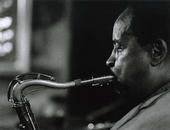The story of saxophonist Ed Wiley, jr. is a familiar one in jazz history. A young African-American takes to music at an early age in a southern town, plays all kinds of musical venues, models himself after the leading exponents of his instrument, records several hit records, moves from his hometown, tours, raises a family, and years later reappears on the scene to let everyone know that he can still represent. We know of the jazz artists who created this uniquely American art form and garnered international acclaim-Pops, Duke, Dizzy, Bird and Monk, to name a few. But there are many unacknowledged musicians who influenced the big names and spent their entire musical lives in the communities that spawned the creativity in the first place, and set the stage for the next generation of young lions. Such is the case with Ed Wiley, Jr.
To understand the music of Ed Wiley, Jr., one must know the musical and cultural environment of his hometown, Houston, Texas. In jazz folklore, cities like New Orleans, Kansas City, Chicago, Detroit, Philadelphia, and New York have gotten most of the ink, and for good reason. However, as Wiley remembers, Houston was a potent laboratory for young, African-American scientists of sound. "Houston was very musical," he recalls. "It might not have gotten the ink that other cities have, but we had quite a few prominent musicians like Clarence Gee, Illinois Jacquet, Arnett Cobb, Curtis Amey, Clarence Stickey...We had quite a few.
It was in this Gulf crucible that Wiley absorbed the blues, gospel, rhythm and blues influences that coalesced to form the "Texas Tenor" sound popularized by saxophonists Illinois Jacquet, Arnett Cobb, Buddy Tate and others. "The Texas tenor sound was an aggressive approach to whatever type of tune you were doing," Wiley says. "It’s a big sound, and soulful as can be. You had tenor players from that area, and you grew up hearing that sound." Wiley remembers how his sound developed while performing in venues that demanded amplification without a microphone. "I played the carnival circuit. They had what you call tent shows before the main show, and the band would playing in what they called the ’valley,’ to get the people in the crowd interested enough to come into the tent. There were no microphones out there, and you had to really dig down deep in your horn and get some volume. So it strengthened your chops and you were used to that big, full sound. When I was coming up in high school [Booker T. Washington, 1946], I played in the marching bands on the football field, and you got strong doing that too."
Like other musicians of his generation, Wiley played on rhythm and blues record dates produced by upstart mom and pop companies. "I worked with Big Joe Turner, Clarence Gatemouth Brown, and I recorded "Cry, Cry Baby" for Sittin’ In With records in 1950."
But by the time he moved from Houston to Baltimore (shortly after that recording) to live with a relative and attend the Baltimore Institute for the Musical Arts, the record was a Cash Box hit, remaining in the Billboard Top 3 for 16 consecutive weeks.
"I formed a band, not knowing that this record was a hit," Wiley says. "In Baltimore, I worked with [tenor saxophonists] Johnny Sparrow and Avery Ross, [pianist] Clyde Patterson, and [guitarist] Rufus Nance. I did some gigs with Ray Charles before he became famous. In Columbus, Ohio, he was working with Lowell Fulsom’s band, and that group was the intermission band for our group, which shows how times have changed. We also had a vocal group with our band. They later left us and went to Motown records; they called themselves the Moonglows. They wanted me to go to Detroit too, but I said, ’No. I’m gonna stay on the road.’"
Although Wiley stayed on the road for a few more years, he married his vocalist, Maye Robinson, and settled into family life in Baltimore and Philadelphia. Although he recorded occasionally during that period - his 1971 vocal "Young Generation" b/w "Stretchin’ Out" was a moderate hit - but he went to trade school and became a machine mechanic, which he said was necessary to feed seven hungry children. Two decades later, with his children were grown and educated, Wiley returned to performing, recording and touring full-time. In 1993, he recorded "Until Sunrise" for Swing Records, a label founded by his son, Ed Wiley III. He followed that with at least four other Swing releases. Two of those, "In Remembrance (1995) and "Sassy" (2001) earned critical acclaim.
"In Remembrance" - featuring such renowned musicians as bassist Milt Hinton, pianist Shirley Scott, drummers Mickey Roker and Bobby Durham, trombonist Wycliffe Gordon and trumpeter Terell Stafford - is Wiley’s musical expression of the African American experience in America, from Negro spirituals to bebop.
"Sassy" - featuring pianist Sir Roland Hanna, trumpeter Nicholas Payton, trombonist Al Grey, alto saxophonist Donald Harrison, guitarists Mark Whitfield and Paul Bollenback, organist Joey DeFrancesco, bassist Charles Fambrough, and drummers Ben Riley and Carl Allen - is a funky, bluesy swinging romp that was among the top 20 jazz CDs released that year.
His latest release, "About the Soul," features Kenny Barron and John Hicks on piano; Keter Betts on bass; Jimmy Ponder and Kevin McNeal on guitar; and Ben Riley and Mickey Roker on drums. The music on this 2006 release is just as the title proclaims - Soulful!
..
